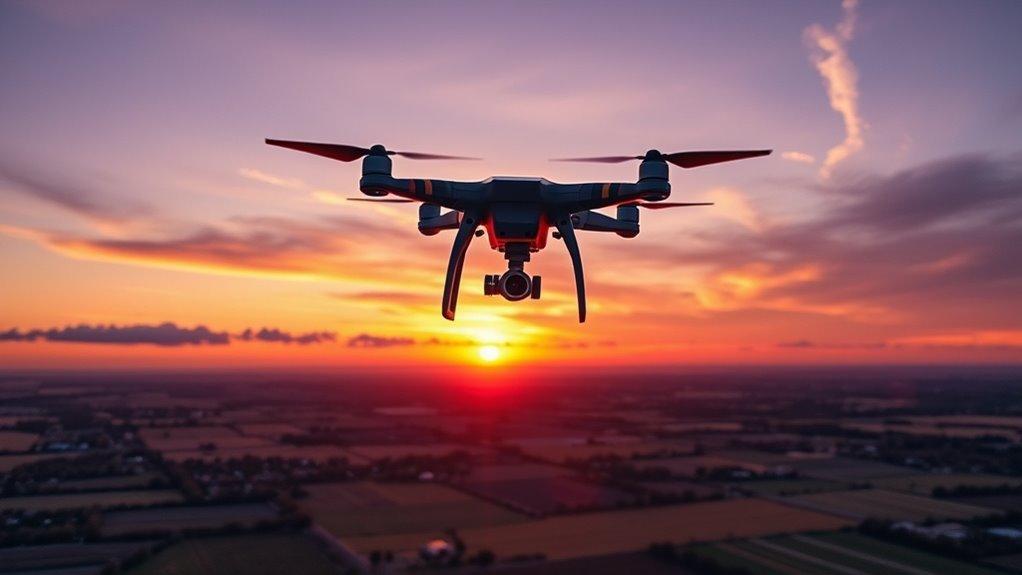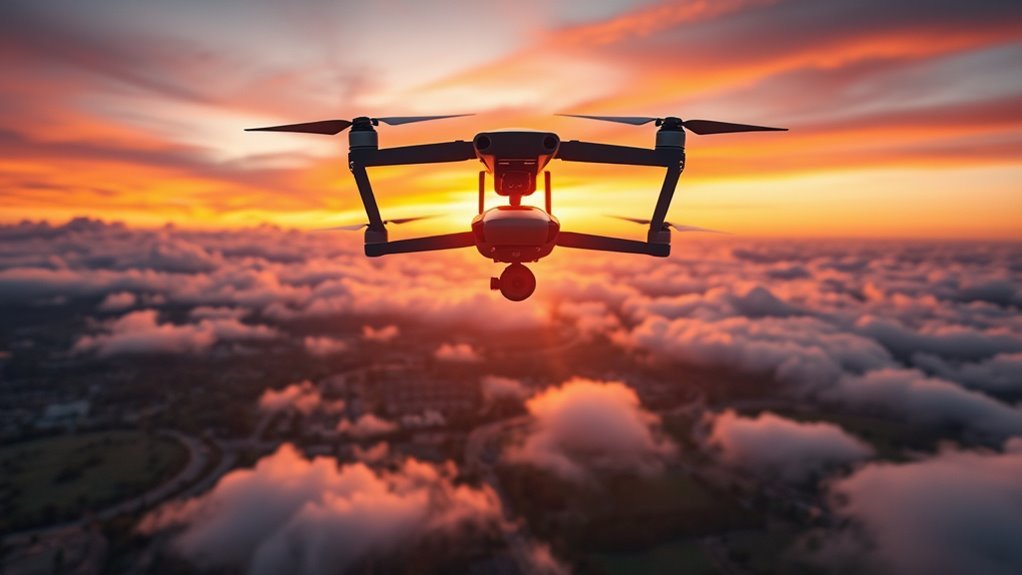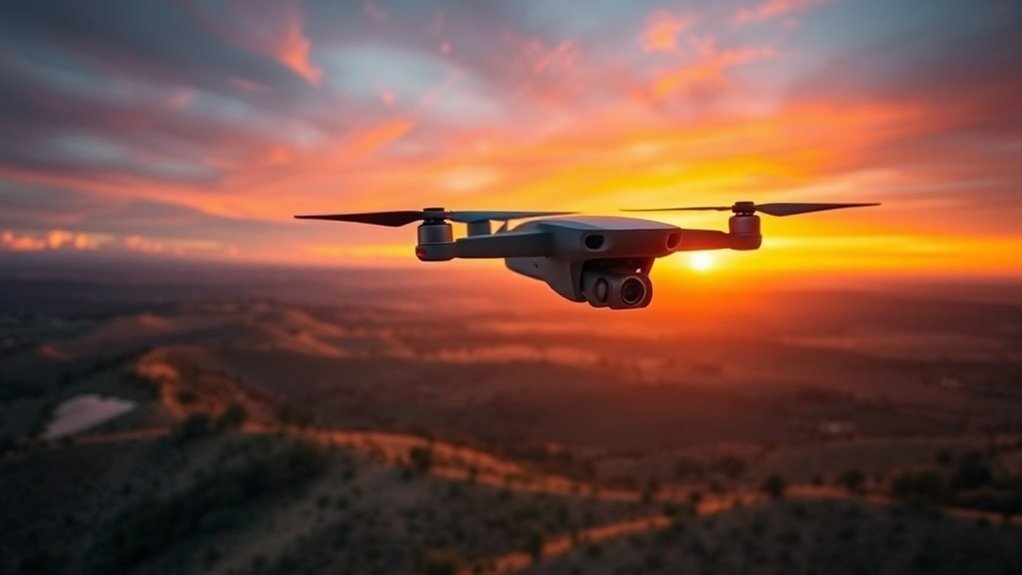Drones can fly up to 400 feet above ground level (AGL) without needing FAA authorization. This altitude limit helps avoid conflicts with manned aircraft and maintains safety in airspace. If you’re operating in controlled airspace, such as Class B, C, D, or E, you’ll need prior approval. Remember, staying in compliance not only keeps you legally protected but also enhances operational efficiency. Explore further to discover important regulations and best practices for safe drone operation.
Understanding Drone Regulations

As you explore the limits of drone flight, it’s important to understand the regulations that govern their operation. Familiarizing yourself with these laws is key for ensuring drone safety and maximizing your flying experience. Different flight zones have specific rules; for instance, commercial and recreational drones must adhere to unique requirements. You’ll need to know where you can legally operate without infringing on airspace controlled by authorities. Staying informed about no-fly zones, such as near airports or densely populated areas, is crucial. Additionally, it is essential to recognize that federal regulations supersede individual claims to airspace control. Understanding these FAA regulations can help prevent potential legal complications and enhance your ability to enjoy your drone without complications.
The FAA’s Altitude Limitations

While maneuvering drone flight, understanding the FAA’s altitude limitations is vital for compliance and safety. The FAA restricts most drones to an altitude measurement of 400 feet AGL (Above Ground Level) to minimize conflicts with manned aircraft and maintain airspace integrity. However, certain conditions allow for higher flight, such as when flying from a structure exceeding 400 feet. Knowledge of these parameters is essential for those utilizing drone technology, as exceeding altitude limits can lead to enforcement actions. By adhering to these regulations, you not only protect yourself from legal repercussions but also foster a safer airspace for all operators. Staying informed guarantees you can exercise your freedom responsibly while enjoying the vast potential of drone technology.
Visual Line of Sight Requirements

Understanding visual line of sight (VLOS) is essential for operating drones safely and legally. This requirement mandates that you maintain a direct, unobstructed view of your drone during flight, ensuring compliance with FAA regulations. Failure to adhere to VLOS can compromise safety and lead to regulatory penalties.
Definition of Visual Line
Visual line of sight (VLOS) is a fundamental concept in drone operation, defining the requirement that pilots maintain a direct view of their aircraft throughout the flight. This guarantees that you can effectively manage your drone’s position and actions, minimizing risks.
| Aspect | Description |
|---|---|
| Definition | Direct visual contact with the drone |
| Importance | Guarantees operational safety and control |
| Compliance | Required for FAA regulations and safety |
Maintaining VLOS allows for better situational awareness, enabling you to react promptly to obstacles or emergencies. Ultimately, understanding VLOS is essential for responsible drone operation, granting you the freedom to explore the skies while adhering to regulatory standards.
Importance for Safety
Maintaining a visual line of sight (VLOS) is essential for ensuring safety during drone operations, as it allows you to make real-time assessments of your drone’s environment. By keeping your drone within sight, you can promptly identify potential hazards, such as obstacles or other aircraft, which is vital for effective risk management. This practice not only enhances drone safety but also fosters responsible flying, empowering you to respond swiftly to any unforeseen circumstances. VLOS requirements help establish a framework for operational freedom while ensuring that safety remains paramount. Ultimately, adhering to VLOS guidelines enables you to enjoy the advantages of drone technology without compromising safety, allowing for a more secure and enjoyable flying experience.
Compliance With Regulations
While drone technology continues to evolve, compliance with regulations, particularly those governing visual line of sight (VLOS), remains critical for safe operations. You must maintain VLOS at all times, ensuring the drone is within your direct line of sight. This requirement not only enhances safety but also mitigates risks, potentially lowering your drone insurance premiums. Understanding VLOS is essential for effective pilot certification; without it, you risk violating FAA regulations. As you navigate the skies, remember that freedom comes with responsibility. Staying informed about VLOS regulations enables you to operate safely while maximizing your operational capabilities. Ultimately, prioritizing compliance protects both your investment and the integrity of the airspace.
Flying in Controlled Airspace
When operating drones in controlled airspace, you need to understand the specific regulations that govern altitude limits and flight permissions. Familiarizing yourself with the authorization process is crucial to guarantee compliance and safety. By grasping these key points, you can navigate controlled airspace effectively.
Understanding Controlled Airspace Regulations
Understanding controlled airspace regulations is vital for drone operators, as compliance guarantees both safety and legality. In the U.S., controlled airspace types include Class A, B, C, D, and E, each with distinct operational requirements. Familiarizing yourself with airspace classification helps you navigate these zones effectively. For instance, Class B airspace surrounds major airports and requires explicit authorization to operate within it. Conversely, Class G, or uncontrolled airspace, allows for more freedom but still demands awareness of nearby activities. By adhering to these regulations, you guarantee not only your safety but also that of other airspace users. Therefore, knowing where and how you can fly is key in maximizing your operational freedom while remaining compliant with federal guidelines.
Altitude Limits for Drones
Drones are subject to specific altitude limits, particularly when flying in controlled airspace, which vary depending on the airspace classification. In controlled airspace, your drone technology must adhere to strict altitude restrictions: typically, you can’t fly above 400 feet in Class G airspace, while Class B, C, D, and E airspaces impose additional limitations. These altitude challenges become vital as they guarantee safety and compliance with manned aircraft operations. If you want to navigate higher altitudes, you’ll need to understand the specifics of each airspace type. By familiarizing yourself with these regulations, you can maximize your drone’s potential while respecting the boundaries of controlled airspace, assuring both freedom and safety in your aerial pursuits.
Authorization Process Overview
Although maneuvering through controlled airspace can seem intimidating, obtaining authorization for drone flights is a systematic process that guarantees compliance with regulations. To navigate this application process effectively, you’ll need to follow these key steps:
- Identify the airspace: Determine if you’re flying in controlled airspace (Class B, C, D, or E).
- Understand authorization requirements: Familiarize yourself with the specific criteria for your intended flight.
- Complete the application: Use the FAA’s Low Altitude Authorization and Notification Capability (LAANC) system or the traditional method.
- Receive confirmation: Await your authorization, which can take minutes to several days, depending on the method used.
Exceptions to the Altitude Rules
While most regulations impose strict altitude limits on drone operations, certain exceptions exist that can allow for higher flights under specific conditions. These exceptions scenarios generally revolve around altitude clarification for specific tasks such as emergency services, agricultural applications, or when flying in controlled airspace with prior authorization.
| Exception Type | Description |
|---|---|
| Emergency Services | Drones may fly higher to assist in urgent situations. |
| Agricultural Use | Higher altitudes may be permitted for crop monitoring. |
| Research Purposes | Academic studies might justify elevated drone flights. |
| Filming & Photography | Aerial shots may require increased altitude limits. |
| Public Safety | Law enforcement may operate drones at higher altitudes. |
Understanding these exceptions can enhance your operational freedom and compliance.
Special Circumstances Requiring Authorization
In circumstances where standard regulations don’t apply, obtaining authorization is essential for operating drones at higher altitudes. Understanding the special circumstances that require regulatory nuances can help you navigate these requirements effectively. Here are four key situations where you’ll need to secure authorization:
Navigating drone regulations requires understanding when special authorization is necessary for higher altitude operations.
- Emergency Response: If you’re responding to natural disasters or emergencies, you’ll likely require special clearance.
- Research Activities: Academic or scientific studies may necessitate higher altitudes beyond standard limits.
- Commercial Operations: Certain commercial tasks, like aerial filming over populated areas, will demand approval.
- Restricted Airspace: Operating in areas near airports or military zones requires explicit FAA authorization. Additionally, it’s important to be aware of drone safety regulations to ensure compliance with all operational guidelines.
Consequences of Non-Compliance
Failing to comply with drone regulations can lead to significant legal and financial repercussions. If you operate your drone beyond the authorized altitude, you risk facing legal repercussions that could include fines or even criminal charges. The FAA enforces strict guidelines, and ignoring them can jeopardize your freedom to fly. Financial penalties can range from hundreds to thousands of dollars, depending on the severity of the violation. Additionally, a non-compliance record may hinder your ability to obtain necessary permits in the future, limiting your operational freedom. Remember, while the skies seem open, they’re regulated for safety. Staying informed and compliant is crucial to protect your rights as a drone operator and guarantee a sustainable flying experience. Engaging with local drone regulations is essential for avoiding potential pitfalls and ensuring responsible drone usage.
Best Practices for Safe Drone Operation
To guarantee safe drone operation, it’s vital to follow established best practices that minimize risks and enhance compliance with regulations. Here are four essential guidelines:
- Conduct a pre flight checklist: Verify all systems are functioning, including battery levels, GPS, and camera equipment.
- Know your airspace: Familiarize yourself with local regulations and restricted zones to avoid potential legal issues.
- Establish emergency procedures: Plan for possible malfunctions or loss of signal, and know how to safely land or recover your drone.
- Maintain visual line of sight: Always keep your drone within your sight to prevent accidents and maintain control. Additionally, understanding battery performance can help maximize flight time and ensure your drone operates efficiently during missions.
Resources for Drone Pilots
Following best practices for safe drone operation sets a solid foundation for your flying experience, but having access to reliable resources can greatly enhance your skills and knowledge as a drone pilot. Utilize the following table for essential drone resources and pilot tools to elevate your flying capabilities:
| Resource Type | Name | Purpose |
|---|---|---|
| Online Courses | UAV Coach | Training and certification |
| Flight Apps | DJI GO | Flight planning and control |
| Regulatory Info | FAA’s UAS website | Compliance and updates |
| Community Forums | Drone Pilots Forum | Networking and knowledge sharing |
Leverage these resources to stay informed and confident in your flying endeavors. With the right pilot tools, you’ll access the true potential of your drone experience. Additionally, understanding real-time monitoring can significantly improve your operational efficiency in various drone applications. It’s also essential to familiarize yourself with local regulations to ensure compliance and safety while flying.
Frequently Asked Questions
Can Hobbyists Fly Drones Higher Than 400 Feet Without Authorization?
Curiosity killed the cat, but it shouldn’t ground your drone. Hobbyists must adhere to drone regulations, keeping flights below 400 feet. Ignoring these responsibilities risks safety and potential legal consequences, so stay informed and comply.
Are There Specific Drones That Can Exceed FAA Altitude Limits?
There are drones with advanced altitude technology that can exceed FAA limits, but their capabilities must comply with regulations. You’ve got to balance performance potential with legal restrictions to guarantee safe, responsible flying.
What Happens if I Accidentally Fly Above the Altitude Limit?
Flying above altitude limits could feel like soaring to the moon, but the consequences of violations can be severe. Stay aware of altitude limits to avoid fines, penalties, or even losing your flying privileges entirely.
How Can I Report Illegal Drone Flights Above the Altitude Limit?
To report illegal drone flights, follow drone reporting guidelines. Document the incident, noting details like time and location. Be aware that altitude violation consequences can include fines or legal action, impacting both operators and airspace safety.
Do Altitude Restrictions Apply to Commercial Drone Deliveries?
Daring drone deliveries demand diligence! You must adhere to commercial drone regulations; delivery altitude limits are essential. Flying beyond these boundaries can lead to hefty fines, so staying informed guarantees your operations remain compliant and free.

